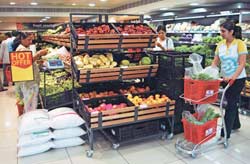Caution is back in boardroom discussions in corporate India. There is still optimism, but irrational exuberance—a phrase popularised by Alan Greenspan, former chairman of the US Federal Reserve—has, for all practical purposes, gone out of the picture. Perhaps, for the best. According to the International Monetary Fund (IMF), the world economic growth is poised to slow down to 3.7 per cent—the lowest in nearly five years, as developed economies battle the R word. India, intertwined with the world more than ever before, is also seeing its own growth estimates getting revised downwards from highs of 8-plus per cent to between 7 and 8 per cent for the year 2008-09. And it seems that slackening demand is not the only thing that is circulating through the world economy. It is also high food, fuel and metals inflation.

Consumers bear the brunt of inflation
Global factors are stoking inflation in India, too. A combination of policy measures (such as not increasing retail fuel prices) has partly insulated India from the worst of global inflation. Nevertheless, at 7.41 per cent in the week ended March 29, the increase in wholesale price index (WPI) has signalled political worries ahead of several state assembly polls.
Prime Minister Manmohan Singh recently pointed out that inflation threatens the constituency for reforms. It is expected that the central bank will signal higher interest rates and pull the brakes harder on the economy. There may be contentions on how slow India will grow. The silver lining appears to be in the fact that even drastic cutbacks in estimates predict a growth at the very least of 7 per cent. And that for an economy flirting with the $1-trillion (Rs 40 lakh crore) mark is still a pretty good growth rate.
It would do us well to remember that the 9 per cent growth phenomenon is a fairly recent one for India. We do not have the pipeline in terms of physical and human capital to cope with this growth. This has become evident in the dearth of infrastructure and the steep salary increases, both of which blunt India’s edge in the global market place. Perhaps a little breather in the breakneck pace of growth is not unwelcome. It will give us time as an economy and a nation to adjust to new priorities, to think and plan big. As the Finance Minister pointed out recently at the Lee Kuan Yew School of Public Policy in Singapore, India has no option but to aim to grow at a high rate over the next 10-20 years. So, let us reform and be back with Version 2.0 of Booming India.

